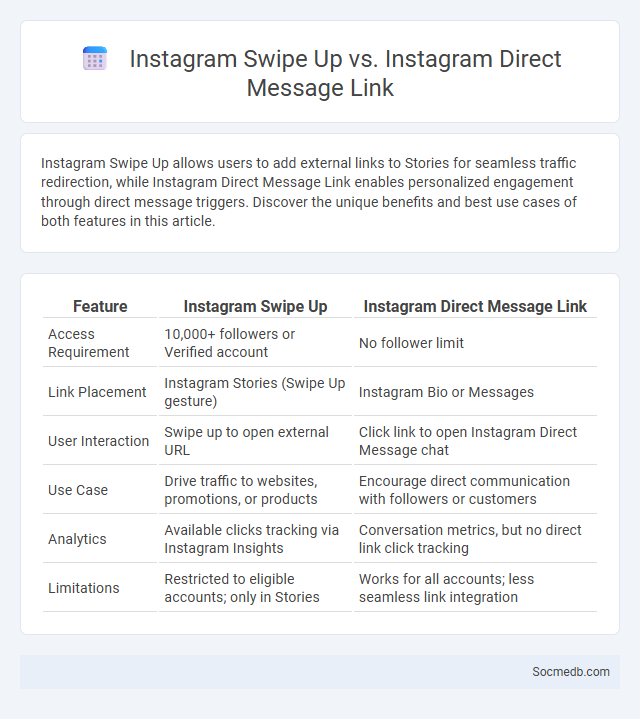
Photo illustration: Instagram Swipe Up vs Instagram Direct Message Link
Instagram Swipe Up allows users to add external links to Stories for seamless traffic redirection, while Instagram Direct Message Link enables personalized engagement through direct message triggers. Discover the unique benefits and best use cases of both features in this article.
Table of Comparison
| Feature | Instagram Swipe Up | Instagram Direct Message Link |
|---|---|---|
| Access Requirement | 10,000+ followers or Verified account | No follower limit |
| Link Placement | Instagram Stories (Swipe Up gesture) | Instagram Bio or Messages |
| User Interaction | Swipe up to open external URL | Click link to open Instagram Direct Message chat |
| Use Case | Drive traffic to websites, promotions, or products | Encourage direct communication with followers or customers |
| Analytics | Available clicks tracking via Instagram Insights | Conversation metrics, but no direct link click tracking |
| Limitations | Restricted to eligible accounts; only in Stories | Works for all accounts; less seamless link integration |
Understanding Instagram Swipe Up Feature
The Instagram Swipe Up feature enables users with over 10,000 followers or verified accounts to add direct links to their Stories, enhancing user engagement with seamless navigation to external websites. This functionality drives traffic for businesses, influencers, and marketers by allowing quick access to product pages, blogs, or promotions without disrupting the viewing experience. Understanding its analytics helps optimize content strategy and improve conversion rates effectively.
What is the Instagram Direct Message Link?
Instagram Direct Message Link is a URL that allows users to send private messages directly to your Instagram inbox, simplifying communication and enhancing engagement with your audience. By sharing this link on websites, emails, or other social platforms, you enable followers and potential customers to connect instantly without searching your profile. Your Instagram Direct Message Link streamlines interaction, boosting customer service and personal connection on social media.
Key Differences: Swipe Up vs Direct Message Link
Swipe Up links on social media stories allow users to access external websites instantly, providing seamless traffic generation for brands, but are typically limited to accounts with over 10,000 followers. Direct Message (DM) links, however, facilitate private, one-on-one communication by encouraging users to initiate conversations within the platform, boosting engagement and personalized interactions without follower count restrictions. Using Swipe Up maximizes reach for content promotion, while DM links enhance customer service and relationship building through direct responses.
Eligibility Requirements for Swipe Up
To access the Swipe Up feature on social media, your account typically needs at least 10,000 followers or a verified status to ensure authenticity and engagement. Your account must be either a business or creator profile, meeting platform guidelines to enable seamless linking to external content. Meeting these eligibility requirements empowers you to drive traffic directly from your stories, enhancing user interaction and conversion rates.
Setting Up an Instagram Direct Message Link
Creating an Instagram Direct Message (DM) link enables seamless communication by allowing users to initiate conversations directly through hyperlinks. By using the format "https://instagram.com/direct/t/USERNAME," businesses and influencers can drive customer engagement and streamline support. Embedding this link on websites, email signatures, or social media profiles enhances accessibility and boosts interaction rates.
Engagement Rates: Swipe Up vs Direct Message Link
Engagement rates on social media vary significantly between Swipe Up features and Direct Message (DM) links, with Swipe Up typically generating higher click-through rates due to its seamless integration in stories and ease of use. DM links, while offering more personalized interaction opportunities, often result in lower direct engagement but can foster deeper customer connections and higher-quality leads. Brands aiming to maximize interaction should analyze their audience behavior to balance quick access through Swipe Up with the personalized service offered by direct messaging.
Best Use Cases for Swipe Up
Swipe Up links on social media provide a powerful tool for driving direct traffic to product pages, event registrations, or exclusive content, enhancing user engagement and conversion rates. Brands effectively utilize Swipe Up to promote time-sensitive offers and flash sales, leveraging urgency to boost immediate response from followers. Influencers and marketers capitalize on this feature to streamline content discovery, offering seamless access to tutorials, blog posts, or affiliate products without disrupting the user experience.
When to Use the Direct Message Link
Use the direct message link when you want to initiate private, one-on-one conversations that require confidentiality or personalized responses. This method is ideal for customer support inquiries, sensitive information exchange, or building deeper connections with your audience. Your ability to quickly respond through direct messages can enhance engagement and foster trust.
Pros and Cons: Swipe Up vs Direct Message Link
Swipe Up on social media offers seamless access to external content, boosting user engagement and driving traffic to websites or products with just one swipe. However, this feature is limited to accounts with over 10,000 followers, restricting its availability and potentially excluding smaller creators from its benefits. Your choice between Swipe Up and Direct Message links should consider your audience size and the level of personal interaction you want to foster.
Choosing the Right Feature for Your Instagram Strategy
Selecting the right Instagram feature depends on your content goals and target audience engagement patterns, emphasizing reels for short, engaging videos and stories for real-time interactions. Utilizing Instagram Shopping can boost e-commerce by directly linking products, while IGTV supports longer-form content to deepen brand storytelling. Analyzing performance metrics for each feature helps optimize your strategy and maximize reach and conversion rates.
 socmedb.com
socmedb.com